UPSC GS 1
Bob Khathing Museum of Valour
- News: Defence Minister Rajnath Singh recently inaugurated the Major Ralengnao ‘Bob’ Khathing Museum of Valour at Tawang in Arunachal Pradesh.
- About Ralengnao Bob Khathing:
-
- Ralengnao ‘Bob’ Khathing was born on February 28, 1912, in the Ukhrul district of Manipur, and belonged to the Tangkhul Naga community.
-
- World War II and Military Service:
-
- During World War II, he became the first Manipuri to receive a King’s Commission.
- He was honored as a Member of the British Empire (MBE) for rallying Naga support against the Japanese in both Burma and India.
- Additionally, he was awarded the Military Cross (MC) for his acts of extraordinary bravery.
-
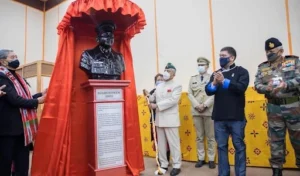
- Bob Khathing’s Army Service:
-
- Initially commissioned into the 9/11 Hyderabad Regiment (now known as the Kumaon Regiment), he was later transferred in 1942 to the Assam Regiment in Shillong.
- As part of the Second World War effort, he served in the Victor Force, a guerrilla unit formed by the British to counter the Japanese along the Burma-India road.
- He acted as an advisor to SANCOL, a unit formed in June 1944 and composed of the 153 Gurkha Parachute Battalion under Major John Saunders.
-
- Role in Tawang Integration:
-
- Khathing played a pivotal role in leading the peaceful expedition to integrate Tawang into Indian territory.
-
- Contributions to Security Frameworks:
-
- His efforts were instrumental in establishing key military and security organizations such as the Sashastra Seema Bal, Nagaland Armed Police, and the Naga Regiment.
-
- Diplomatic Career:
-
- Khathing was the first tribal-origin individual to serve as India’s ambassador to Burma, now known as Myanmar.
-
Tumaini Festival
- News: Refugees performed a traditional cultural dance during the Tumaini Festival at Dzaleka Refugee Camp in Dowa, central Malawi, recently.
- Tumaini Festival:
-
- Established in 2014, the Tumaini Festival is a unique cultural event held annually at the Dzaleka Refugee Camp in Malawi.
- It stands out as the only festival in the world conducted within a refugee camp.
- The festival is organized and managed by refugees themselves, creating a platform that promotes community, solidarity, and cultural exchange.
- It attracts thousands of attendees every year, with performances by artists from various countries.
- The festival features a wide range of artistic forms, including music, dance, theater, and visual arts.
- In 2024, the festival was honored with the Cultures of Resistance (CoR) Award.
-
Read also: Understand Global Hunger Index: Tackling Hunger in India | UPSC
- Key Facts about Malawi:
-
- Malawi is a landlocked country situated in Southeastern Africa, covering 118,484 square kilometers.
- It shares borders with Tanzania, Mozambique, and Zambia.
- The capital city is Lilongwe.
- The official languages are English and Chichewa.
- The currency used is the Malawian kwacha (MWK).
- Known for its striking highlands and large lakes, Malawi occupies a narrow strip of land along the East African Rift Valley.
- Lake Nyasa (also called Lake Malawi), which is one of the world’s deepest lakes, makes up more than 20% of the country’s area.
- Malawi’s economy is predominantly agricultural, with over 80% of the population involved in farming.
- Despite its natural beauty, Malawi remains one of the world’s poorest countries.
-
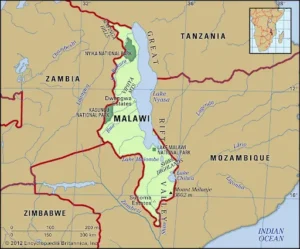
- Dzaleka Refugee Camp:
-
- Located in Malawi, Dzaleka is the country’s only permanent refugee camp.
- It was established in 1994 to accommodate people fleeing violence, genocide, and wars from countries such as Burundi, Rwanda, and the Democratic Republic of Congo (DRC).
- Over the past 30 years, the camp has also provided refuge to people from Somalia, Ethiopia, and other nations.
-
UPSC GS 2
Central Water Commission (CWC)
- News: Glacial lakes and other water bodies across the Himalayan region saw a 10.81 per cent increase in area from 2011 to 2024 due to climate change, according to the Central Water Commission’s report.
- Central Water Commission (CWC):
-
- The Central Water Commission (CWC) is India’s premier technical organization dedicated to water resources management.
- It operates as an attached office under the Ministry of Jal Shakti, specifically the Department of Water Resources, River Development, and Ganga Rejuvenation, Government of India.
- The Commission’s headquarters is located in New Delhi.
-
- Functions of CWC:
-
- The CWC is responsible for initiating, coordinating, and advancing various water resource projects across India, in collaboration with State Governments.
- Its work includes schemes related to flood control, irrigation, navigation, drinking water supply, and the development of water power.
- The Commission also conducts investigations, as well as manages the construction and execution of specific water resource schemes when necessary.
-
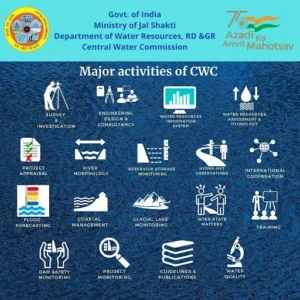
- Organizational Structure:
-
- The CWC is led by a Chairman, who holds the position of Ex-Officio Secretary to the Government of India.
- The Commission’s operations are divided into three main wings:
- Designs and Research (D&R) Wing
- River Management (RM) Wing
- Water Planning and Projects (WP&P) Wing
- Each wing is overseen by a full-time member, who holds the status of Ex-Officio Additional Secretary to the Government of India.
- These wings are further divided into multiple organizations, each tasked with handling specific responsibilities related to water resources management.
-
- Training and Capacity Building:
-
- The National Water Academy, located in Pune, is an integral part of the CWC and is responsible for training engineers from both central and state departments.
- The Academy operates under the direct supervision of the CWC Chairman.
-
UPSC GS 3
Orphan Drugs
- News: Orphan drugs, critical in treating rare diseases, have increasingly gained attention in India following the implementation of the National Policy for Rare Diseases (NPRD) in 2021.
- Orphan Drugs:
-
- Orphan drugs are pharmaceutical agents designed to treat rare diseases, also known as orphan diseases.
- These diseases, though affecting a small portion of the population, often lead to life-threatening or chronically debilitating conditions.
- Definitions of orphan drugs vary according to different regulatory frameworks.
-
- Orphan Drugs in India:
-
- India does not have a formal prevalence-based definition for orphan drugs. However, the National Policy for Rare Diseases (NPRD) of 2021 provides a framework for diagnosing and treating rare diseases, with an expected low prevalence threshold for orphan drugs.
-
- Categories of Orphan Drugs:
-
- Orphan drugs are classified based on the type of disease they target and their regulatory status.
- Common categories include genetic disorders, rare cancers, metabolic disorders, and autoimmune conditions.
-
- Examples of Conditions Treated by Orphan Drugs:
-
- Genetic disorders: Diseases like cystic fibrosis and Duchenne muscular dystrophy often require orphan drug treatment.
- Rare cancers: Conditions such as neuroblastoma and gliomas are included in orphan drug development.
- Metabolic disorders: Disorders like Gaucher’s disease and Fabry disease are addressed through orphan drugs.
- Autoimmune diseases: Conditions like systemic sclerosis also fall within the scope of orphan drug development.
-
- Criteria for Orphan Drug Designation:
-
- For a drug to be classified as an orphan drug, it must meet specific criteria that differ across countries. These generally include:
- The disease must have a low prevalence.
- The condition should lack approved treatments, or the drug should offer significant advantages over existing treatments.
- Developers must provide scientific evidence that the drug can treat or alleviate the rare condition.
- This evidence can be submitted at various stages, from preclinical research to advanced clinical trials.
-
- Incentives for Orphan Drug Development:
-
- Once designated as an orphan drug, developers receive several incentives to promote their development:
- Market exclusivity for a specified period.
- Tax credits to offset research and development (R&D) costs.
- Fee waivers for regulatory applications, making the drug approval process more accessible.
-
Namo Drone Didi
- News: The Union government has approved the Central Sector Scheme ‘Namo Drone Didi’ for providing drones to the women self-help groups (SHGs) under DAY-NRLM, with an outlay of ₹1,261 crore.
- Namo Drone Didi:
-
- This scheme is designed to empower Women Self Help Groups (SHGs) under the DAY-NRLM program.
- The initiative helps SHGs offer drone-based agricultural services to farmers.
- Drones will be procured by LFCs and managed by the Cluster Level Federations (CLFs) of SHGs.
-
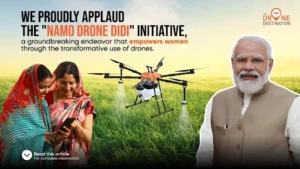
- Duration:
-
- The scheme is scheduled to run from 2024 to 2026.
-
- Aim:
-
- Its primary goal is to introduce technological advancements in agriculture, aiming to improve crop efficiency and reduce farming costs.
-
- Objectives:
-
- Empowerment: Equip women SHGs with drone technology.
- Agricultural Efficiency: Utilize advanced tools to enhance productivity in farming.
- Additional Income: Enable SHGs to generate supplementary income by providing drone rental services.
-
- Implementation Structure:
-
- At the central level, governance is overseen by an Empowered Committee of Secretaries from key departments, including Agriculture & Farmers’ Welfare, Rural Development, Fertilizers, Civil Aviation, and Women & Child Development.
-
- Financial Assistance and Subsidies:
-
- Central Financial Assistance: SHGs will receive an 80% subsidy on drone packages, with a maximum limit of ₹8 lakhs per SHG.
- Loan Options: SHGs can cover the remaining balance through loans from the Agriculture Infrastructure Fund (AIF), which comes with a 3% interest subvention, or through other financial sources.
-
- Drone Package Details:
-
- Equipment Package: Includes drones with spray assemblies, batteries, chargers, cameras, and protective gear.
- Additional Support: SHGs will receive extra batteries, propellers, nozzles, and tools to ensure continuous operations.
- Maintenance: Drones come with a one-year onsite warranty, a two-year annual maintenance contract, and a one-year comprehensive insurance plan.
-
- Training and Skill Development:
-
- Pilot Training: A 15-day course will train selected SHG members in drone operation and agricultural applications.
- Drone Assistant Training: Other SHG members or their family members will be trained in drone maintenance and repairs.
- Management Information System (MIS): A specialized “Drone Portal” will provide end-to-end monitoring of service delivery, fund allocation, and real-time tracking of drone usage.
-
- Benefits:
-
- Sustainable Livelihoods: SHGs will gain an additional source of income through drone services.
- Agricultural Efficiency: The use of drones will enhance crop yields and reduce farmers’ operational costs.
-
Vajra Prahar
- News: The Indian Army contingent recently departed for the 15th edition of India- US joint Special Forces Exercise VAJRA PRAHAR.
- VAJRA PRAHAR Exercise:
-
- The 15th edition of the India-US joint Special Forces exercise, VAJRA PRAHAR, is being conducted.
- The previous iteration took place in December 2023 at Umroi, Meghalaya.
- It is the second India-US Army joint exercise in 2024, following Exercise YUDH ABHYAS, which was held in Rajasthan in September.
-
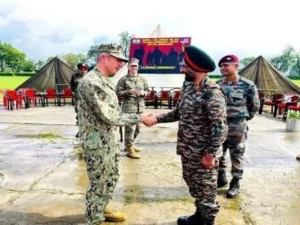
- Location of Exercise:
-
- The exercise is taking place at the Orchard Combat Training Centre in Idaho, USA.
-
- Duration:
-
- The exercise is scheduled from November 2 to November 22, 2024.
-
- Participants:
-
- Each side is represented by 45 personnel.
- The Indian Army is represented by its Special Forces units, while the US Army is represented by the Green Berets.
-
- Objectives of the Exercise:
-
- Military Cooperation: Strengthen the military partnership and cooperation between India and the US.
- Interoperability: Enhance joint tactics, interoperability, and mutual understanding in special operations.
-
- Focus Areas of Training:
-
- Physical Fitness: A strong focus on maintaining high physical standards.
- Joint Planning and Tactical Drills: Collaborative planning and execution of missions.
- Special Operations Tactics: Training focused on desert and semi-desert operational environments.
-
- Expected Outcomes:
-
- Enhanced Capabilities: Improved combined abilities for conducting joint Special Forces operations.
- Best Practices: Exchange of operational experiences and best practices.
- Camaraderie: Development of mutual trust and camaraderie between Indian and US forces.
-
Read also: The Gig Economy in India: Growth, Challenges & Insights | UPSC
Exercise ‘Garud Shakti’
- News: Indian Army contingent departed to Indonesia for joint exercise ‘Garud Shakti’.
- Location:
-
- The exercise is being conducted in Cijantung, Jakarta, Indonesia.
-
- Duration:
-
- The event is scheduled from November 1 to November 12, 2024.
-
- Participants:
-
- The Indian contingent consists of 25 personnel from the Parachute Regiment (Special Forces).
- The Indonesian contingent includes 40 personnel from the Indonesian Special Forces unit, Kopassus.
-
- Objective:
-
- Enhance Cooperation and Interoperability: Strengthen mutual cooperation, understanding, and interoperability between Indian and Indonesian Special Forces.
- Exchange of Best Practices: Share knowledge on weaponry, equipment, innovations, tactics, techniques, and procedures.
- Cultural Exchange: Foster stronger military ties by gaining insights into each other’s culture and lifestyle.
-
- Activities and Training Focus:
-
- Special Operations Training: Focus on planning and executing special operations, with an emphasis on enhancing special forces skills.
- Joint Tactical Exercises: Conduct joint tactical drills, including operations in jungle terrain, simulated strikes on terrorist camps, and a validation exercise integrating basic and advanced special forces techniques.
-
- Significance:
-
- Strengthening Bilateral Relations: This exercise deepens military cooperation and fortifies ties between the armies of India and Indonesia.
- Shared Security Objectives: It provides a platform for both nations to work towards common security goals.
- Skill Development and Exchange: The exercise facilitates the sharing of expertise and best practices in special forces operations.
-

